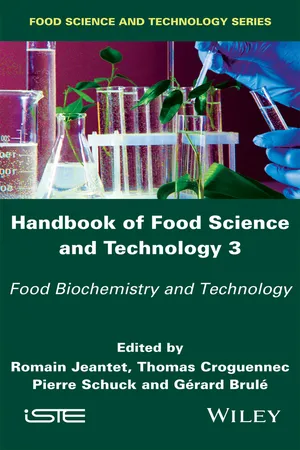
Handbook of Food Science and Technology 3
Food Biochemistry and Technology
- English
- ePUB (mobile friendly)
- Available on iOS & Android
Handbook of Food Science and Technology 3
Food Biochemistry and Technology
About This Book
This third volume in the Handbook of Food Science and Technology Set explains the processing of raw materials into traditional food (bread, wine, cheese, etc.). The agri-food industry has evolved in order to meet new market expectations of its products; with the use of separation and assembly technologies, food technologists and engineers now increasingly understand and control the preparation of a large diversity of ingredients using additional properties to move from the raw materials into new food products.
Taking into account the fundamental basis and technological specificities of the main food sectors, throughout the three parts of this book, the authors investigate the biological and biochemical conversions and physicochemical treatment of food from animal sources, plant sources and food ingredients.
Frequently asked questions
Information
PART 1
Food from Animal Sources
1
From Milk to Dairy Products
1.1. The biochemistry and physical chemistry of milk
- – lactose (4.8 – 5% (w/w) of overall composition);
- – protein (3.2 – 3.5% (w/w));
- – non-protein nitrogen (NPN) consisting of urea, amino acids and peptides, representing about 5% of the nitrogen fraction of milk;
- – inorganic minerals (calcium, phosphate, chloride, potassium, sodium) and organic acids (mainly citric acid in fresh milk);
- – water-soluble vitamins.
1.1.1. Milk fat

1.1.1.1. Composition and characteristics of milk fat
| Class of lipids | Percentage of total lipids (w/w) |
| Triacylglycerols | 97.5 |
| Diacylglycerols | 0.36 |
| Monoacylglycerols | 0.027 |
| Free fatty acids | 0.1 |
| Cholesterol | 0.31 |
| Hydrocarbons | Traces |
| Carotenoids | 0.008 |
| Phospholipids | 0.6 |
| Fatty acids | Symbol | % mol | Distribution on the glycerol sites (% mol) | Melting point (°C) | ||
| Sn1 | Sn2 | Sn3 | ||||
| Butyric | 4:0 | 4.8 | - | - | 35.4 | -7.9 |
| Caproic | 6:0 | 2.2 | - | 0.9 | 12.9 | -1.5 |
| Caprylic | 8:0 | 1.3 | 1.4 | 0.7 | 3.6 | +16.5 |
| Capric | 10:0 | 2.9 | 1.9 | 3.0 | 6.2 | +31.4 |
| Lauric | 12:0 | 3.3 | 4.9 | 6.2 | 0.6 | +43.6 |
| Myristic | 14:0 | 10.8 | 9.7 | 17.5 | 6.4 | +53.8 |
| Palmitic | 16:0 | 26.1 | 34.0 | 32.3 | 5.4 | +62.6 |
| Palmitoleic | 16:1 | 1.4 | 2.8 | 3.6 | 1.4 | -0.5 |
| Stearic | 18:0 | 10.8 | 10.3 | 9.5 | 1.2 | +69.3 |
| Oleic | 18:1 | 24.1 | 30.0 | 18.9 | 23.1 | +14.0 |
| Linoleic | 18:2 | 2.4 | 1.7 | 2.5 | 2.3 | -5.0 |
| Linolenic | 18:3 | 1.1 | - | - | - | -11.0 |
- – a high proportion of short-chain fatty acids (chain lengths of four to ten carbons) synthesized from acetate and β-hydroxybutyrate produced by microorganisms during cellulose degradation in the rumen. These fatty ...
Table of contents
- Cover
- Table of Contents
- Title
- Copyright
- Introduction
- PART 1: Food from Animal Sources
- PART 2: Food from Plant Sources
- PART 3: Food Ingredients
- Bibliography
- List of Authors
- Index
- End User License Agreement